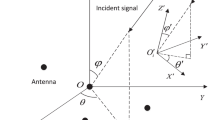Abstract
Based on the theory of polarization filtering and the merits of interference suppressions when adopting oblique projections, a novel polarization filtering algorithm is proposed in this paper. The proposed method can effectively separate the target signal and interference without additional transformation and compensation processing, and the target does not suffer distortions after separation. The suggested scheme is still valid when the target and interference hold the same polarized angle but different phase difference in polarized angle. We extend the application to the scope of known target polarization but unknown interference polarization, finding that the interference is restrained and the amplitude/phase of the target are both totally kept. Theoretic analysis and mathematical deduction show that the proposed scheme is a valid and simple implementation. Simulation results also demonstrate that the suggested method can obtain better filtering performance than the conventional polarization filtering (CPF) and the null-phase-shift polarization filtering (NPSPF). It is proved that the proposed OPPF is an extension to the CPF and the NPSPF, and it develops the theory of polarization filtering effectively.
Similar content being viewed by others
References
Mao X P, Liu Y T, Deng W B. Null phase-shift instantaneous polarization filter (in Chinese). Acta Electron Sin, 2004, 32: 1495–1498
Mao X P, Liu Y T, Deng W B. Frequency domain null phase-shift polarization filter (in Chinese). Acta Electron Sin, 2008, 36: 537–542
Mao X P, Liu Y T. Validity of polarization filtering technique (in Chinese). J Harbin Institute Tech (Nat Sci), 2002, 34: 577–580
Mao X P, Liu Y T. Null phase-shift polarization filtering for high-frequency radar. IEEE Trans AES, 2007, 43: 1397–1408
Giuli D. Suboptimum adaptive polarization cancellers for dual-polarization radars. Proceed IEE Pt. F, 1988, 135: 60–62
Poelman A J. Virtual polarization adaptation-A method of increasing detection capability of a radar system through polarization-vector processing. Proceed IEE Pt. F, 1981, 128: 261–269
Poelman A J, Guy J R F. Multinotch logic-product polarization suppression filters-A typical design example and its performance in a rain clutter environment. Proceed of IEE Pt, F, 1984, 131: 383–396
Mao X P, Mark J W. A polarization UWB receiver with narrowband interference suppression capability. In: Proceedings of WCNC, Hong Kong, China, 2007. 1639–1643
Cao B, Liu A J, Mao X P, et al. An oblique projection polarization filter. In: Proceedings of WiCOM, Dalian, China, 2008. 1893–1896
Behrens R T, Scharf L L. Signal processing applications of oblique projection operators. IEEE Trans Signal Process, 1994, 42: 1413–1424
Piet V, Marc M. Two deterministic blind channel estimation algorithms based on oblique projections. Signal Process, 2000, 80: 481–495
Chen M H, Wang Z Y. Subspace tracking in colored noise based on oblique projection. In: Proceedings of ICASSP, III, Toulouse, France, 2006. 556–559
Scharf L L, Friedlander B. Matched subspace detectors. IEEE Trans Signal Process, 1994, 42: 2146–2157
Neira L R. Oblique matching pursuit. IEEE Signal Process Lett, 2007, 14: 703–706
Yu X, Tong L. Joint channel and symbol estimation by oblique projections. IEEE Trans Signal Proces, 2001, 49: 3074–3083
Remy B, Guillaume B. Oblique projections for direction-of-arrival estimation with prior knowledge. IEEE Trans Signal Process, 2008, 56: 1374–1387
McCloud M L, Scharf L L. A new subspace identification algorithm for high-resolution DOA estimation. IEEE Trans Antenn Propagat, 2002, 50: 1382–1390
Huang J Y, Wang Y P. The application of Weibull distribution in prediction for the rain induced depolarization of millimeter waves (in Chinese). Acta Electron Sin, 1993, 21: 93–96
Yang R K, Huang J Y, Lv X H. Identification for the rain induced depolarization discrimination in millimeter wave propagation (in Chinese). J XiDian Uni (Nat Sci), 2000, 27: 487–490
Huang J Y, Chen L H. Analysis on attenuation and depolarization induced by the rain n millimeter wave (in Chinese). Chin J Radio Sci, 1993, 8: 29–40
Zheng L F, Liu G L. Adaptive compensation techniques for rain depolarization at millimeter wavelength (in Chinese). J XiDian Univ (Nat Sci), 1989, 16: 185–196
Antoine R, Jocelyn C, Jerome I M. Estimation of polarization parameters using time-frequency representations and its application to waves separation. Signal Process, 2006, 86: 3714–3731
Coon J, Sandell M, Beach M, et al. Channel and noise variance estimation and tracking algorithm for unique-word based single-carrier systems. IEEE Trans Wirel Commun, 2006, 5: 1488–1496
Boumard S. Novel noise variance and SNR estimation algorithm for wireless MIMO OFDM systems. Proceed GLOBECOM, 2003, 3: 1330–1334
Author information
Authors and Affiliations
Corresponding author
Rights and permissions
About this article
Cite this article
Zhang, Q., Cao, B., Wang, J. et al. Polarization filtering technique based on oblique projections. Sci. China Inf. Sci. 53, 1056–1066 (2010). https://doi.org/10.1007/s11432-010-0100-2
Received:
Accepted:
Published:
Issue Date:
DOI: https://doi.org/10.1007/s11432-010-0100-2




